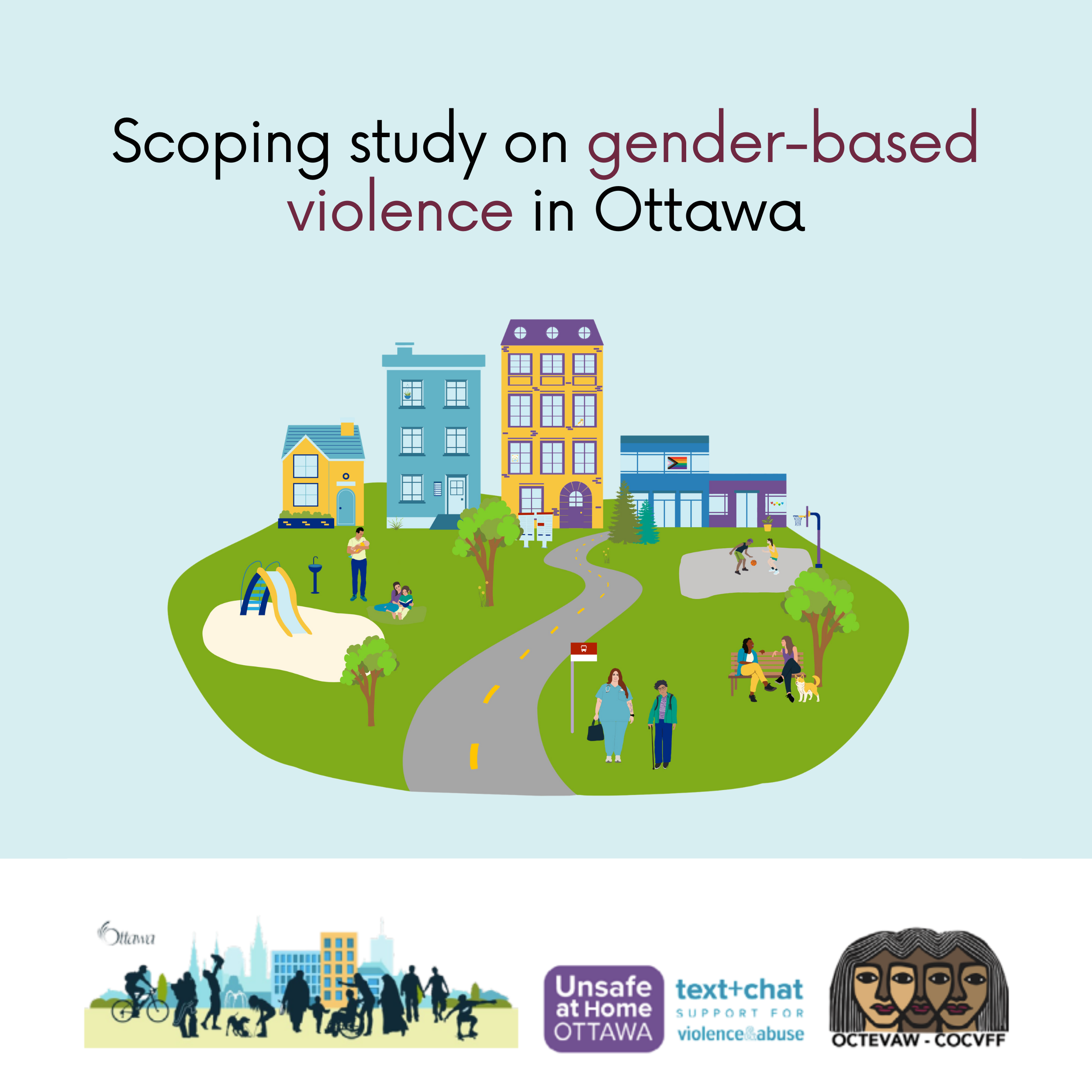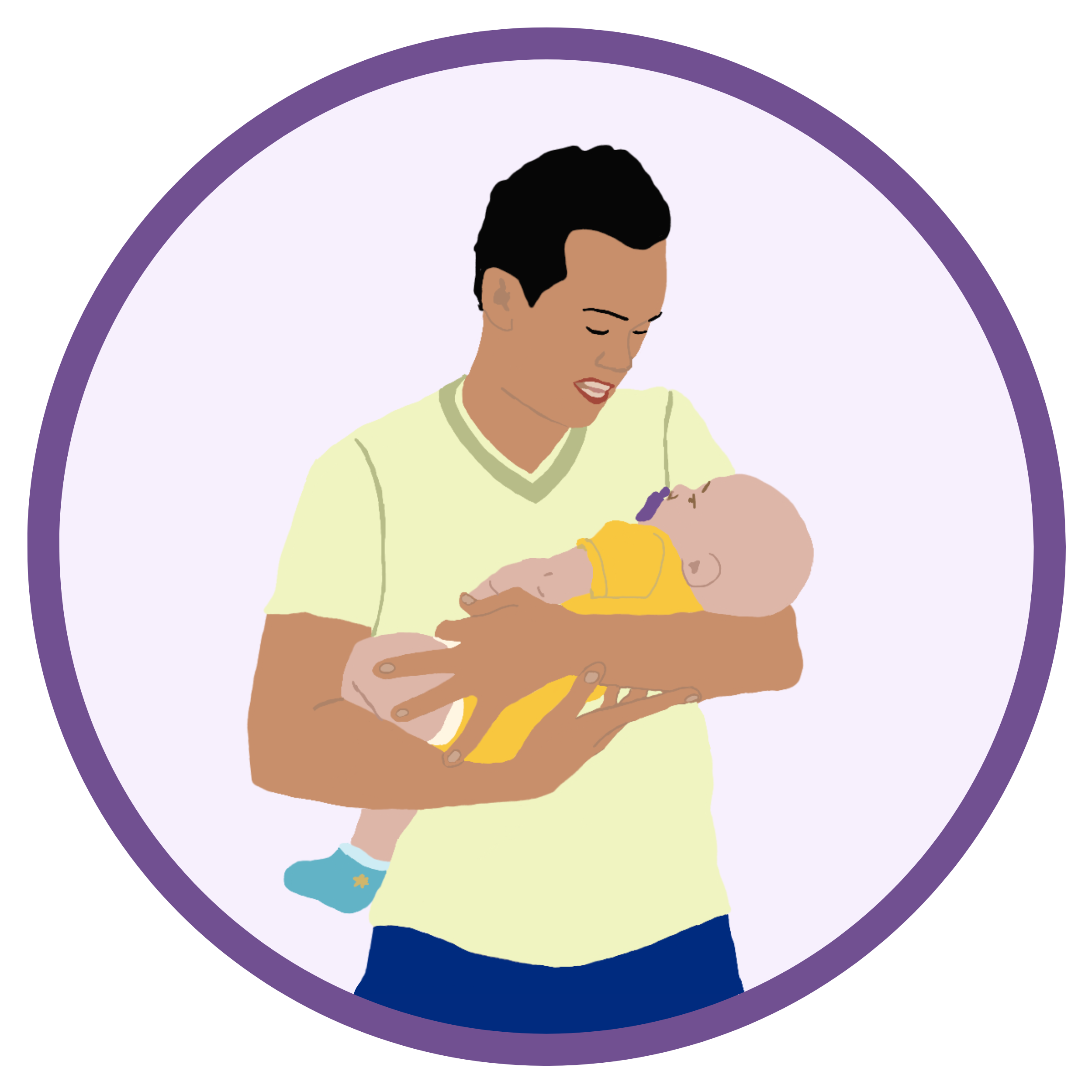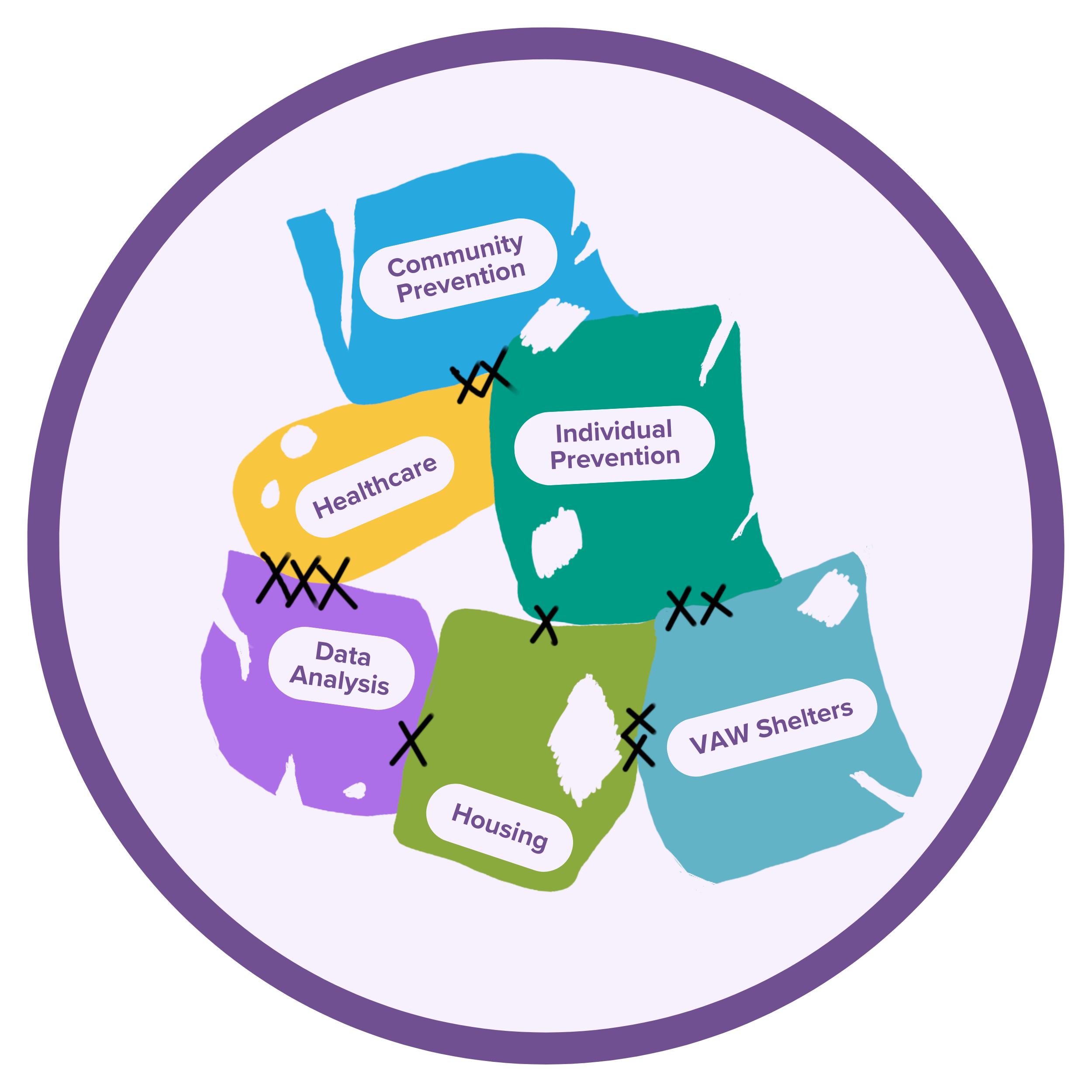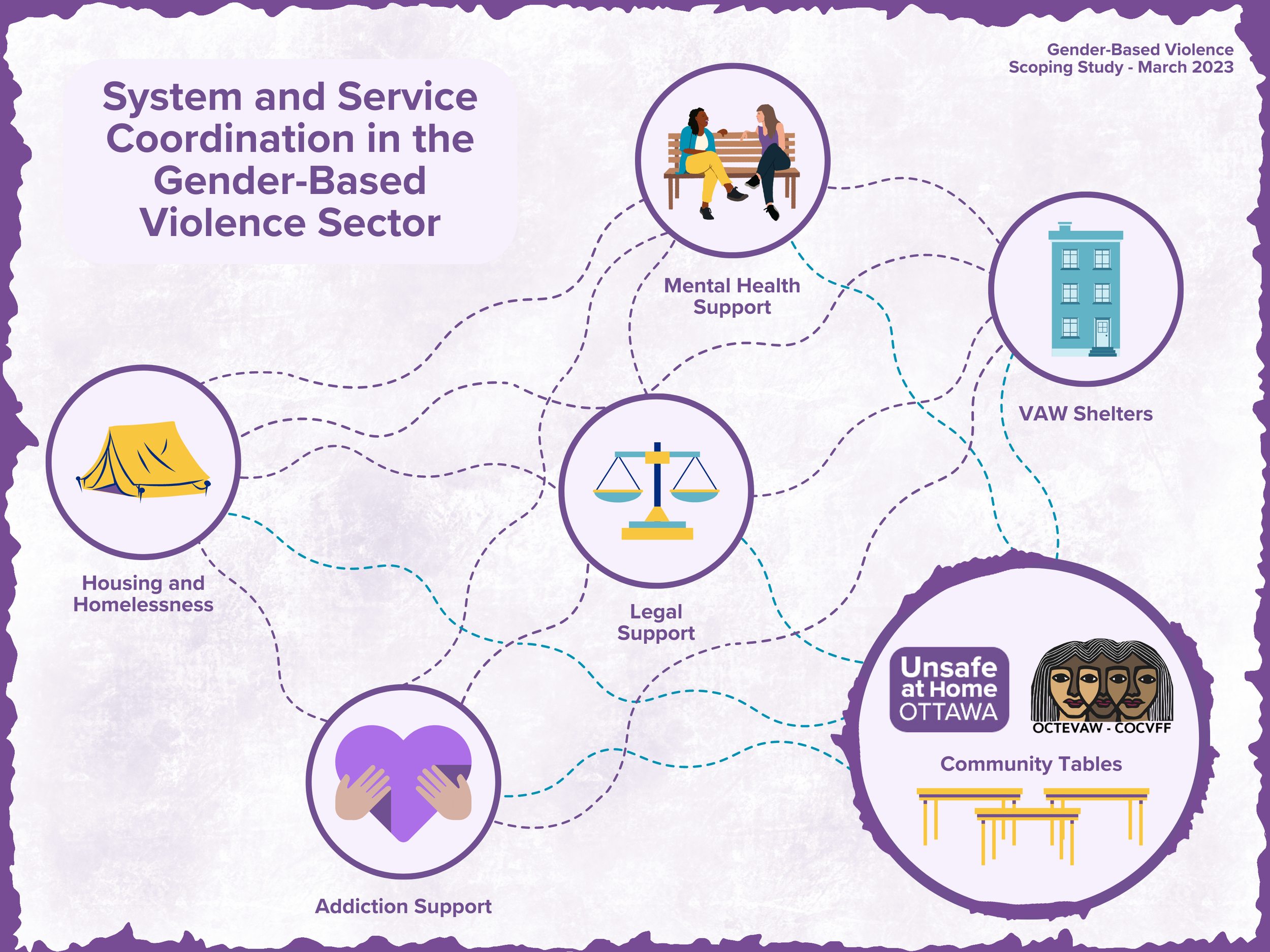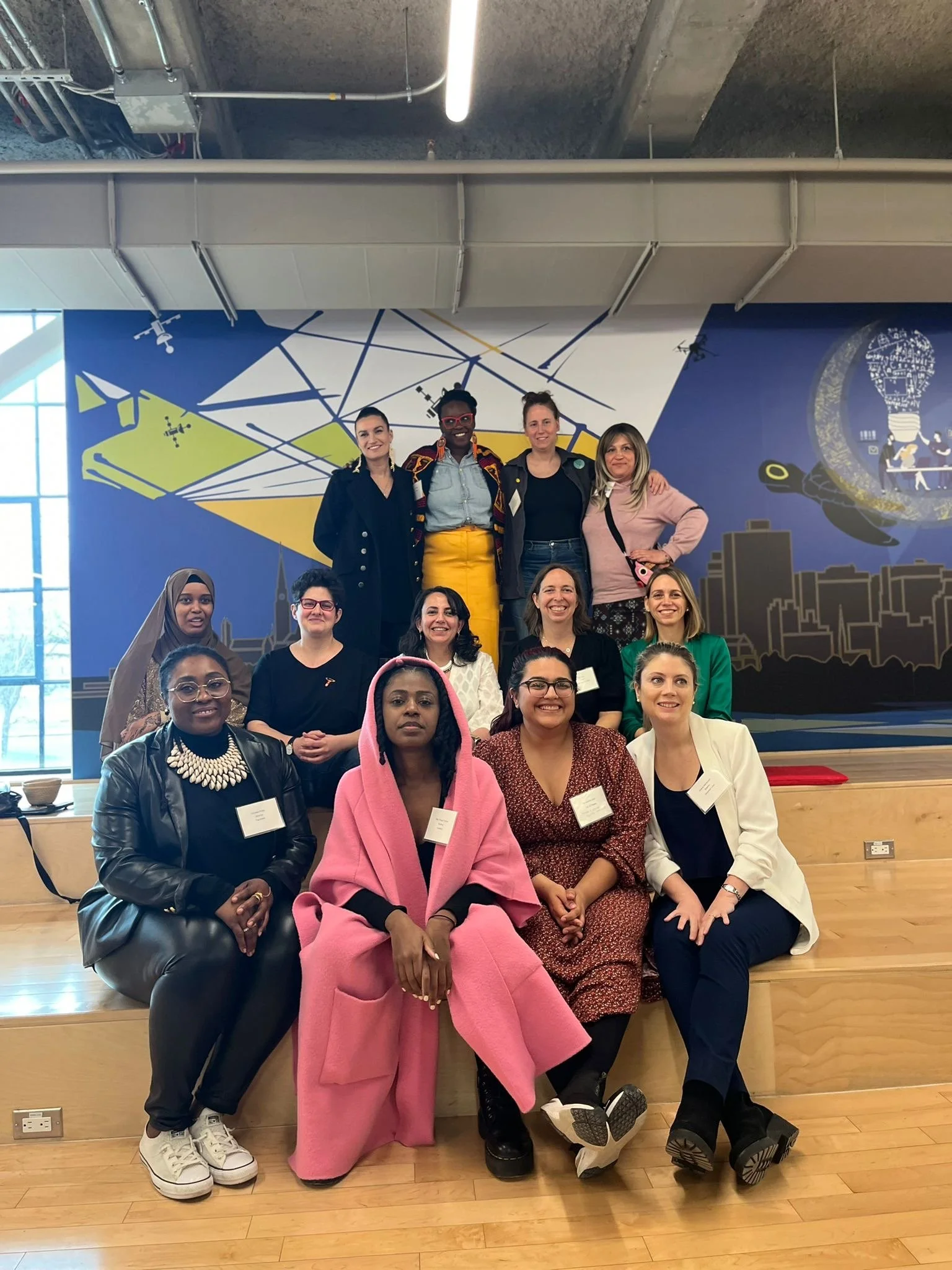Mapping Change:Scoping Study on Gender Based Violence in Ottawa
This project was initiated by the Ottawa Coalition to End Violence Against Women (OCTEVAW) in collaboration with the City of Ottawa and Unsafe at Home as was completed between September 2022 and March 2023. It is the first high-level, systematic study of the GBV sector, and the organizations that interact with it, in Ottawa.
The study used the City’s Women and Gender Equity Strategy definition of GBV: Violence based on gender norms and unequal power dynamics, perpetrated against someone based on their gender, gender expression, gender identity, or perceived gender. It takes many forms, including physical, economic, sexual, as well as emotional (psychological) abuse (Status of Women Canada, 2020).
A few goals of this scoping study were to:
Explore who is burdening the work of service integration for populations with intersecting identities, where the key gaps are, and where needs are not being met.
Map services and programs in Ottawa serving GBV survivors, identify barriers and gaps, and uncover opportunities for future collaborations between the City and the sector.
Support the CSWBP and Women and Gender Equity Strategy (WGES teams to develop action plans and deliver objectives related to preventing and responding to GBV in Ottawa.
Provide an in-depth analysis of service providers’ capacity to collect, collate, analyze, and translate GBV data into evidence based decision-making.
The study was developed and conducted from the perspective of service providers and not service users. All project activities, and all deliverables were developed using an intersectional lens.
For a deep dive, the full report is now publicly available. Key findings and next steps have been summarized below.
This GBV scoping study was informed by two key lenses:
Structural/systemic violence - A form of violence perpetrated against people through systems often as a result of widespread beliefs and socio-political systems, for example, the colonization of Indigenous peoples, or the normalization of gender-based sexual violence.
Intersectionality - A framework for understanding how various aspects of individual identity—including race, gender, social class, and sexuality—interact to create unique experiences of privilege or oppression.
Structural
Housing
Legal supports
Mental Health
Employment
Gender equality
Policy Changes
Individual
Temporary housing
System navigation
Bystander navigation
Speaking out
Crisis Lines
Emergency supports
Five key scoping study findings
Data collected through the GBV scoping study is organized under five key themes:
Funding
System and Service Coordination
Meeting Intersectional Needs
Data Collection and Analysis
Prevention
Finding one: Limitations of Funding
Across the sector, funding was reported as the biggest barrier to meeting the diverse needs of survivors and victims. Funding limitations include funding structures, funding eligibility, and funder priorities.
Data highlights:
72.5% of the organizations reported a lack of adequate financial resources.
50% of GBV shelters reported volunteers supporting their service delivery and programming needs on a weekly basis; whereas 17.5% of organizations noted 51% or more volunteers supporting their program and services. Participants reported that without volunteers, certain programs don’t run at all.
Limited organizational capacity, resulting from lack of trained staff and funding limitations, is the most prevalent reason for survivors being turned away from specialized services.
Long-term funding for dedicated staff to lead/participate in coordination efforts would enable more streamlined, accessible services.
Finding two: System and Service Coordination
Barriers to system and service coordination point to resource challenges - lack of dedicated staff and relevant expertise, language capacities, and challenges sharing information between agencies.
Current sector coordination efforts exist and provide valuable support, however, do not meet the growing complexity and changing needs of the sector.
Important to note that grassroots networks and community members that don’t have a formal affiliation do a lot of work that isn’t visible.
Finding three: Meeting Intersectional Needs
Across the board, GBV organizations and service providers report supporting equity-deserving groups. However, mainstream service providers’ integration of services for survivors with intersecting identities is often done in an ad-hoc way.
Research indicates that mainstream organizations require more funding, dedicated efforts to develop policies and strategies, cross-sectoral collaboration, training, and the will to fill existing gaps in their service delivery.
Data highlights:
Only 17.5% of the organizations reported targeted programs for refugee women; and 12.5% reported programs targeted toward those with no status.
25% of organizations reported programs for the unique needs of those engaged in sex work.
While all GBV shelters reported services for trans women, only 37% reported serving trans men.
Participants also noted lack of diverse staff as a limiting factor for organizations to meet the needs of diverse groups.
The most prominent forms of service integration to meet needs of diverse populations are: language interpretation services, availability of cultural foods, partnerships with cultural organizations, and offering cultural competency training for staff.
Finding four: Data Collection and Analysis
There is a need for discussions on the value of collecting and analyzing data, sector needs, and investment in data tools that centre survivors (e.g. common intake process).
Many organizations use different data collection tools and approaches. This can get in the way of the sector’s ability to engage in coordinated, long-term planning in the following ways:
There is no shared standard on what data is collected and how it is collected, across different service providers.
Frontline staff are often very limited in their capacity to collect data, and at times can lack the will to do so - many competing needs.
There is very little data on certain types of violence (e.g. economic abuse, psychological abuse). As a result, programs and funding to address these types of violence don’t exist.
Tools that are overly technical or not survivor-centred pose an additional challenge. Many survivors do not wish to share their stories and/or have them documented.
Role of data in gender-based violence sector
80% of organizations surveyed collect demographic data
50% of organizations surveyed have trained staff capacity for data analysis
55% of organizaitons surveyed conduct risk assessments for survivors, but they is no shared standard on what data is collected or how.
Finding five: Prevention
Overwhelmingly, organizations report that we need to stop violence before it starts through community capacity building, education, investments in social determinants of health. Funding parameters don’t enable this much needed work.
Community-rooted prevention like bystander training was reported to be the least common form of prevention work in which organizations are engaged. Similarly, while most organizations reported prevention activities that are survivor focused, such as safety planning, few reported addressing root causes through their prevention work and engaging with men and boys.
Data highlights:
75% of organizations recognized prevention as a priority in their programs.
40% of the organizations provide targeted outreach and communications materials for specific communities (e.g. newcomers, immigrant women, Inuit).
27.5% have outreach materials reviewed by the target community to ensure they are culturally relevant and appropriate.
Only 25% of the organizations reported engaging in prevention work involving men and boys.
Next steps for City of Ottawa
The findings of this study conclude that the City of Ottawa has multiple roles to play in addressing GBV at a structural level.
Roles for the City:
Advocate - Acknowledging that GBV (like many other challenges in the City’s social infrastructure) is a cross-jurisdictional issue, findings highlight areas in which the City can play a greater role as an advocate to other levels of government.
Capacity builder - The City of Ottawa can play a cross-cutting role in facilitating GBV prevention and interventions by creating long term action plans, strategies, and directions that are embedded in all aspects of city planning and oversight.
Funder - As a funder, City of Ottawa would have the capacity to make strategic investments toward addressing identified service gaps in the sector. The study findings do not identify the City as the sole entity responsible for investing in the GBV sector. Funding needs to be a priority at all levels of governments, but the findings highlight where the City can assume a greater role in allocating funding toward GBV prevention and services.
In April 2024, a GBV Forumn was held in collboration with the City of Ottawa, GBV Advisory, OCTEVAW and Unsafe at Home. Findings from that convening will be released in November 2024.
Community feedback sessions will be held in Early Winter 2025 to get additional feedback from Ottawa Residents on the action plan.
If you would like to learn more about the scoping study results and gender- based violence, sign up for our newsletter!
Acknowledgements
This work was initiated by the Ottawa Coalition to End Violence Against Women (OCTEVAW) and co-developed with Unsafe at Home Ottawa and the City of Ottawa Community Safety and Well-Being Plan and Women and Gender Equity Strategy teams.
Community Safety and Wellbeing Gender Based Advisory Committee and Consultants at GBV Forum - April 2024
The scoping study benefited from the knowledge, insights, and experiences of representatives from across the gender-based violence sector, including frontline service providers, as well as a number of others who provided support throughout the process.
The project was led by Kimiya Project Lab Inc. on unceded and unsurrendered Algonquin Territory. Thank you to the project team Khulud Baig, Natalie Duchesne, Nour Fatima, Sundus Khan and the design team, Anti-Heroine Media.
Sincerest gratitude as well to members of the Community Advisory Committee:
Abrar Ali, Ottawa Rape Crisis Centre
Jennifer Chafe, Tungasuvvingat Inuit
Maggie Echimane, Ottawa Coalition to End Violence Against Women
Nathalie Lafrenière, Eastern Ottawa Community Resource Center
Erin Leigh, Counselling and Family Services Ottawa
Keri Lewis, Interval House of Ottawa
Candice Shaw, Ottawa Rape Crisis Centre
Pamela Twagirayezu, National Abortion Federation of Canada
Jaisie Walker, Planned Parenthood Ottawa

